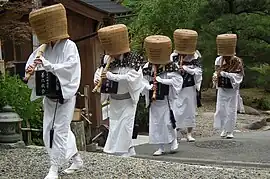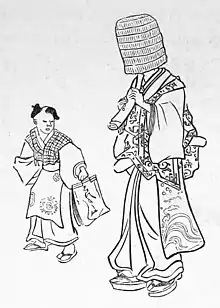| Part of a series on |
| Fuke Zen |
|---|
 |
| People |
|
| Philosophy |
| Places |
|
| Topics |
| Literature |
|



The komusō (虚無僧/こむそう) (also romanized komusou or komuso) were a group of Japanese mendicant monks of the Fuke school of Zen Buddhism who flourished during the Edo period (1603–1867).[1] Komusō were characterized by a straw basket (a sedge or reed hood known as a tengai) worn on the head, manifesting the absence of specific ego but also useful for traveling incognito.[2] They were also known for playing solo pieces on the shakuhachi (a type of bamboo flute). These pieces, called honkyoku ("fundamental pieces"), were played during a meditative practice called suizen, in return for alms as a method of attaining enlightenment.
During the Meiji period (1868–1912), the Japanese government formally abolished the Fuke sect. With former monks bringing the tradition to secular audiences, documentation of the musical repertoire of the performers survived through the period.[3] Small associations and organizations work to continue this musical tradition in the modern era.[4] Hakata Ward holds one of remaining temples where Komusō continue to perform.[5]
History
Though the komusō named their sect Fuke-shū, the sect was never acknowledged as a sect or a sub-sect of Rinzai school of Zen Buddhism.[6] Fuke is the Japanese form of Puhua, a peer of Linji Yixuan (Rinzai), a Zen teacher active in China in the 9th century. Puhua is also mentioned in the Rinzai Analects as a strange person who walked around ringing a bell to summon others to enlightenment.
Some of the komusō in the Edo period (1603–1867) practiced suizen, literally meaning "blowing Zen", a form of meditation through the blowing of a shakuhachi, as opposed to zazen, which is the meditation of quiet sitting practiced by most Zen followers. Suizen pieces (known as honkyoku) prioritized precise breathing control as a function of "mindfulness". The oldest documentation of any named honkyoku piece is in the Shichiku shoshin-shū (Collection of Pieces for beginners on Strings and Bamboo, 1664). This text mentions Kyō Renbo, Goro, Yoshino and other pieces, but it does not mention any of the pieces considered to be the "three classics" (Mukaiji/Mukaiji reibo, Kokū/Kokū Reibo, Kyorei/Shin no Kyorei).
Komusō first appeared in the 17th century, though predecessors are depicted in paintings and texts from around 1500 onwards. There is no evidence of any earlier tradition of shakuhachi-playing monks, and it is recorded that in 1518 the shakuhachi was regarded by some as an instrument for court music (gagaku), not for religious music.[7] The sect was given exclusive right to play the instrument during the Edo-period by the Bakufu as a way to identify their travelling monks.[8]
Travel around Japan was heavily restricted in the Edo period, but the komusō were decreed a rare exemption from the Tokugawa shogunate, most likely for political reasons. The authenticity of this decree was in doubt, despite it being treated as legitimate and amended by future leaders within the shogunate.[9] They were not recognized as a legal monastic entity beyond these token exemptions by the shogunate, and were not eligible to participate in the Danka system.[10]
There had been several uprisings involving masterless samurai (rōnin) during the first half of the 17th century, and by acknowledging the komusō, who by their own regulations had to be of samurai descent,[11] the authorities hoped to control such Rōnin. To be given a free pass in these times was a highly unusual and very special exemption from travel restrictions, and rumors from the period held that in return for this privilege the komusō had to report back to the central government about conditions in the provinces.[12][13]
The Tokugawa government revoked all formal privileges for the komusō in 1847. In 1867 with the fall of the Tokugawa Shogunate, what was left of the Fuke-shū was disbanded.[9] The Meiji government attempted to continue the Danka system, but ended that as well soon after ascending to power. As the komusō were not a part of this system, the sect was outlawed with practitioners going on to teach the shakuhachi as a secular instrument.[14]
Etymology
Komusō (虚無僧) means "priest of nothingness" or "monk of emptiness"; the first two characters, kyomu (虚無) (or komu) means "nothingness, emptiness", with kyo (虚) (or ko) means "nothing, empty, false", and mu (無) meaning "nothing, without". The last character, sō (僧), means "priest, monk".
The priests first known as komusō were referred to as such with the meaning of "straw-mat monk"; later, different characters were used for the same pronunciation, resulting in komusō meaning "priest of nothingness" or "monk of emptiness". The earliest komusō, predecessors of the later "priests of nothingness", were poor beggar monks without any social status in society. The later komusō, on the other hand, had to be of samurai family, even though the practice of teaching shakuhachi to townspeople had become very popular already in the early 18th century.
Flute
The shakuhachi flute was the instrument used to achieve the desired state of meditation by komusō. The instrument derives its name from its size. Shaku is an old unit of measure close to 1 foot (30 cm). Hachi means eight, which in this case represents a measure of eight-tenths of a shaku. True shakuhachi are made of bamboo and can be very expensive.
Disguise and outfit
Komusō wore a tengai (天蓋), a type of woven straw hat or kasa, which completely covered their head like an overturned basket. The idea was that the wearing of such a hat removed the ego of the wearer, whilst also concealing their identity. Further, the government granted the komusō the rare privilege to freely travel the country without hindrance; one reason doing so may have been an interest on behalf of the shogunate to receive first-hand information about conditions in the provinces, the collection of such information made possible by the concealed nature of the komusō.[15]
Komusō wore kimono – especially of a five-crested, formal mon-tsuki style – and obi, as well as an o-kuwara, a rakusu-like garment worn over the shoulders. Komusō would wear a secondary shakuhachi to accompany their primary flute, possibly as a replacement for the samurai's wakizashi; their primary shakuhachi, usually a 1.8 size instrument (I shaku ha sun), would be pitched in what would today be considered D or D flat.
Komusō wore inro from their belt – a container for medicine, tobacco and other items – kyahan shin coverings above their tabi socks and waraji sandals, and a hachimaki headband, covered by the tengai. They wore tekou, hand-and-forearm covers, a fusa tassel, and carried a gebako, a box used for collecting alms and holding documents.
Modern day
After the Tokugawa shogunate fell to the loyalist forces of
Emperor Meiji, komusō temples and their monks were abolished in 1871.[16] The new Meiji government soon decided to ban shakuhachi playing altogether, however, the Kinko Ryu Grandmasters Araki Kodo II (Chikuo I) and Yoshida Ittcho successfully petitioned the new government to allow secular shakuhachi music to continue.[14] Practice of the shakuhachi, however, survived thanks to these efforts,
The major schools of shakuhachi music that survive to today come from two guilds: the Meian and Kinko. These guilds are a synthesis of two sects of an earlier Fuke-shū guild of komusō priests.[3] Members of the general public can learn to play the shakuhachi at the dojo at Icchoken in Hakata-ku, and players who learn all 60 songs of the tradition can be certified as shakuhachi masters.[5]
References
- ↑ Blomberg, Catharina (1994). The Heart of the Warrior: Origins and Religious Background of the Samurai System in Feudal Japan. Catharina Blomberg. pp. 101–103. ISBN 1-873410-13-1.
- ↑ Nishiyama, Matsunosuke; Groemer, Gerald (1997). Edo Culture: Daily Life and Diversions in Urban Japan, 1600-1868. University of Hawaii Press. p. 124. ISBN 0-8248-1736-2.
- 1 2 "Japanese music - Koto, Traditional, Folk | Britannica". www.britannica.com. Retrieved 2023-12-27.
- ↑ Nelson, Ronald. "The International Shakuhachi Society". www.komuso.com. Retrieved 2023-12-27.
- 1 2 Inoue, Mai (2021-09-30). "The Shakuhachi of the Komuso: A Tradition Alive and Well in Hakata". Fukuoka Now. Retrieved 2023-12-27.
- ↑ "The "Ascetic Shakuhachi" Historical Evidence Research Web Pages - by Danish/Icelandic Musician, Music Editor & Japanologist Torsten Olafsson". zen-shakuhachi.dk. Retrieved 2023-12-27.
- ↑ See Linder, Gunnar Jinmei (2012). Deconstructing Traditional Japanese Music: A Study on Shakuhachi, Historical Authenticity and Transmission of Tradition. Stockholm University, PhD Diss.
- ↑ Hughes, David W. (2017-02-03). The Ashgate Research Companion to Japanese Music. Routledge. ISBN 978-1-351-69760-6.
- 1 2 Nelson, Ronald. "The International Shakuhachi Society". www.komuso.com. Retrieved 2023-12-27.
- ↑ Hur, Nam-lin (2007). Death and Social Order in Tokugawa Japan: Buddhism, Anti-Christianity, and the Danka System. Vol. 282 (1 ed.). Harvard University Asia Center. ISBN 978-0-674-02503-5.
- ↑ Brunn, Stanley D. (2015-02-03). The Changing World Religion Map: Sacred Places, Identities, Practices and Politics. Springer. ISBN 978-94-017-9376-6.
- ↑ Nelson, Ronald. "The International Shakuhachi Society". www.komuso.com. Retrieved 2023-12-27.
- ↑ Turnbull, Stephen R. (2005). Warriors of Medieval Japan. Osprey publishing. p. 160. ISBN 1-84176-864-2.
- 1 2 "Komuso shakuhachi monks - Jon Kypros". flutedojo.com. Retrieved 2023-12-27.
- ↑ "Komuso: Japanese Zen Priest", 2008 article by David Michael Weber
- ↑ Deeg, Max. "Komuso and Shakuhachi-Zen From Historical Legitimation to Spiritualisation of a Buddhist Denomination in the Edo Period".
{{cite journal}}: Cite journal requires|journal=(help)
- Liner notes from the music CD Komuso: The Healing Art of Zen Shakuhachi, Ronnie Nyogetsu Seldin, shakuhachi. 2000, The Relaxation Company